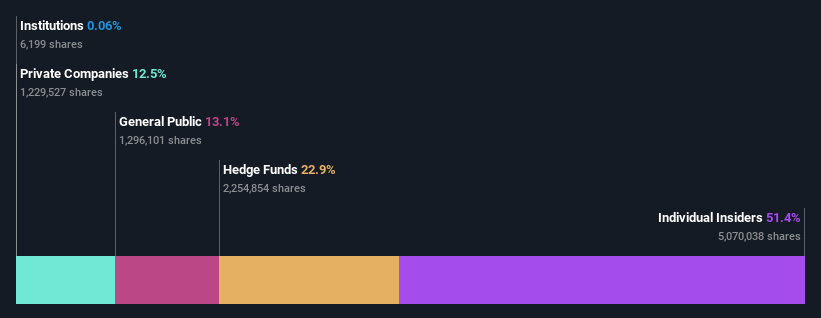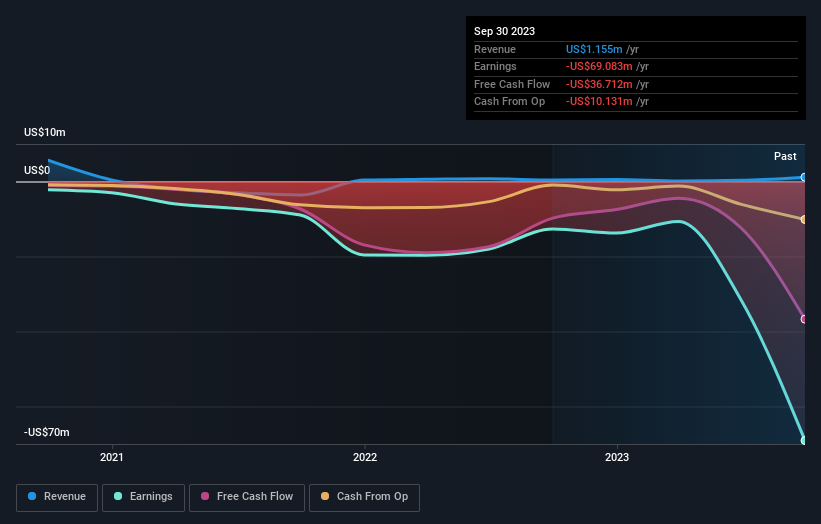Prairie Operating Co. (NASDAQ:PROP) insiders have significant skin in the game with 51% ownership
Key Insights
Insiders appear to have a vested interest in Prairie Operating's growth, as seen by their sizeable ownership
A total of 4 investors have a majority stake in the company with 56% ownership
Past performance of a company along with ownership data serve to give a strong idea about prospects for a business
If you want to know who really controls Prairie Operating Co. (NASDAQ:PROP), then you'll have to look at the makeup of its share registry. And the group that holds the biggest piece of the pie are individual insiders with 51% ownership. In other words, the group stands to gain the most (or lose the most) from their investment into the company.
So, insiders of Prairie Operating have a lot at stake and every decision they make on the company’s future is important to them from a financial point of view.
In the chart below, we zoom in on the different ownership groups of Prairie Operating.
View our latest analysis for Prairie Operating
What Does The Lack Of Institutional Ownership Tell Us About Prairie Operating?
Small companies that are not very actively traded often lack institutional investors, but it's less common to see large companies without them.
There are many reasons why a company might not have any institutions on the share registry. It may be hard for institutions to buy large amounts of shares, if liquidity (the amount of shares traded each day) is low. If the company has not needed to raise capital, institutions might lack the opportunity to build a position. On the other hand, it's always possible that professional investors are avoiding a company because they don't think it's the best place for their money. Institutional investors may not find the historic growth of the business impressive, or there might be other factors at play. You can see the past revenue performance of Prairie Operating, for yourself, below.
It looks like hedge funds own 23% of Prairie Operating shares. That's interesting, because hedge funds can be quite active and activist. Many look for medium term catalysts that will drive the share price higher. Gregory O'Neill is currently the company's largest shareholder with 21% of shares outstanding. Bristol Capital Advisors LLC is the second largest shareholder owning 12% of common stock, and Gary Hanna holds about 12% of the company stock. Gary Hanna, who is the third-largest shareholder, also happens to hold the title of Member of the Board of Directors. Additionally, the company's CEO Edward Kovalik directly holds 12% of the total shares outstanding.
On looking further, we found that 56% of the shares are owned by the top 4 shareholders. In other words, these shareholders have a meaningful say in the decisions of the company.
While studying institutional ownership for a company can add value to your research, it is also a good practice to research analyst recommendations to get a deeper understand of a stock's expected performance. Our information suggests that there isn't any analyst coverage of the stock, so it is probably little known.
Insider Ownership Of Prairie Operating
While the precise definition of an insider can be subjective, almost everyone considers board members to be insiders. The company management answer to the board and the latter should represent the interests of shareholders. Notably, sometimes top-level managers are on the board themselves.
I generally consider insider ownership to be a good thing. However, on some occasions it makes it more difficult for other shareholders to hold the board accountable for decisions.
Our most recent data indicates that insiders own the majority of Prairie Operating Co.. This means they can collectively make decisions for the company. So they have a US$53m stake in this US$102m business. Most would argue this is a positive, showing strong alignment with shareholders. You can click here to see if those insiders have been buying or selling.
General Public Ownership
With a 13% ownership, the general public, mostly comprising of individual investors, have some degree of sway over Prairie Operating. While this size of ownership may not be enough to sway a policy decision in their favour, they can still make a collective impact on company policies.
Private Company Ownership
Our data indicates that Private Companies hold 12%, of the company's shares. It might be worth looking deeper into this. If related parties, such as insiders, have an interest in one of these private companies, that should be disclosed in the annual report. Private companies may also have a strategic interest in the company.
Next Steps:
It's always worth thinking about the different groups who own shares in a company. But to understand Prairie Operating better, we need to consider many other factors. Like risks, for instance. Every company has them, and we've spotted 5 warning signs for Prairie Operating (of which 4 can't be ignored!) you should know about.
Of course this may not be the best stock to buy. So take a peek at this free free list of interesting companies.
NB: Figures in this article are calculated using data from the last twelve months, which refer to the 12-month period ending on the last date of the month the financial statement is dated. This may not be consistent with full year annual report figures.
Have feedback on this article? Concerned about the content? Get in touch with us directly. Alternatively, email editorial-team (at) simplywallst.com.
This article by Simply Wall St is general in nature. We provide commentary based on historical data and analyst forecasts only using an unbiased methodology and our articles are not intended to be financial advice. It does not constitute a recommendation to buy or sell any stock, and does not take account of your objectives, or your financial situation. We aim to bring you long-term focused analysis driven by fundamental data. Note that our analysis may not factor in the latest price-sensitive company announcements or qualitative material. Simply Wall St has no position in any stocks mentioned.


